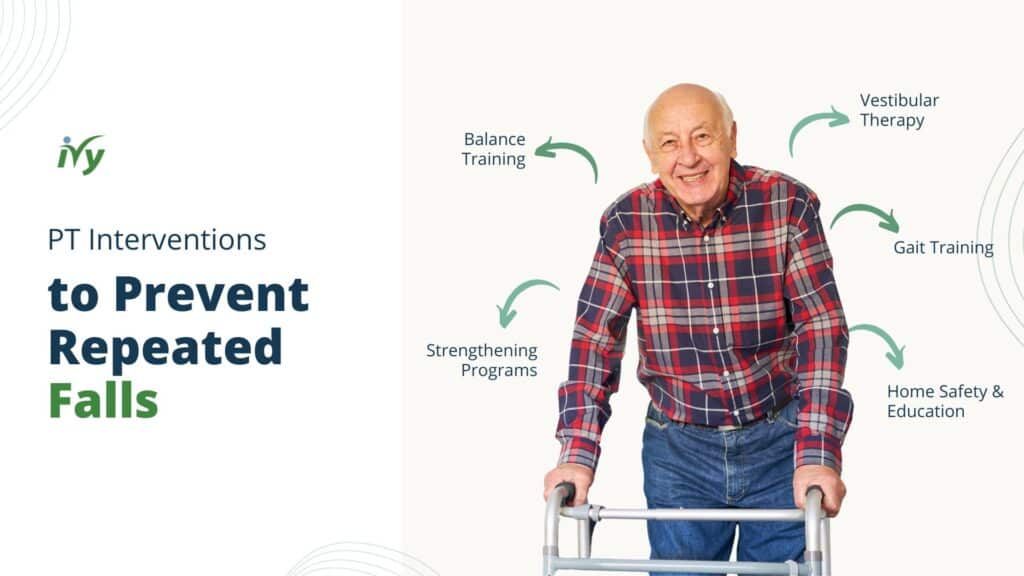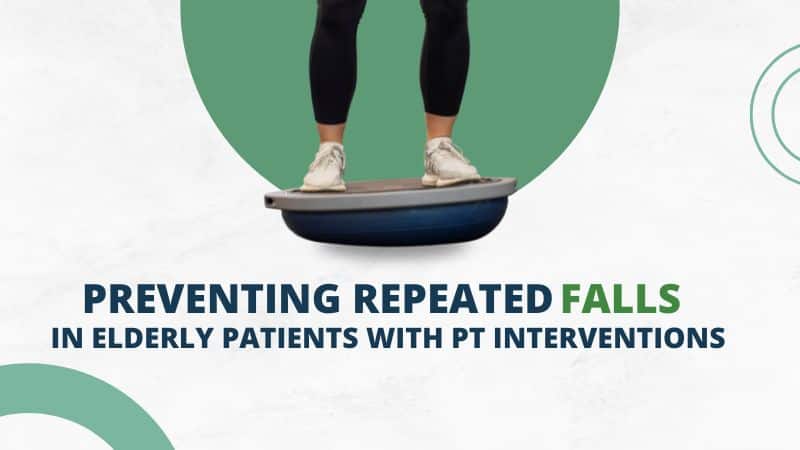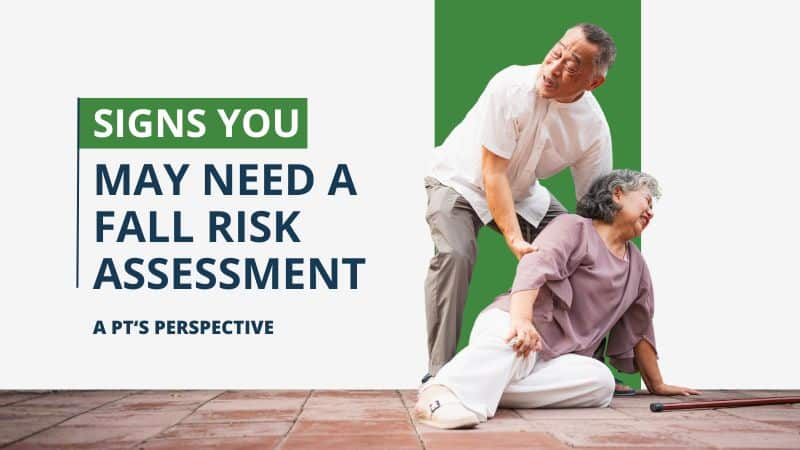Repeated falls in older patients aren’t just bad luck. They’re signals that something deeper is happening and that the next fall could mean a hip fracture, surgery, or even a permanent loss of independence. It’s a dangerous cycle—a fall, then fear, then less movement—that only increases the odds of falling again.
Physical therapy offers a solution to prevent falls. By strengthening weak muscles, retraining balance, and teaching safer ways to move, PT helps older adults rebuild confidence and reduce fall-related risks. At Ivy Rehab, our therapists specialize in fall prevention in elderly patients, with programs tailored to each person’s health history and daily challenges.
Why Repeated Falls Happen in Elderly Patients
Picture this: your parent hesitates at the bottom of the stairs, debating whether to risk the climb. This hesitation is often caused by underlying issues that increase fall risk in older adults. Fueled by fear and weaker balance, it is one of the clearest signs another fall may be on the horizon.
Understanding the causes behind fall risk in older individuals is critical for effective intervention. Many face reduced activity, further increasing their fall risk because they’re afraid of falling again. That reduced activity weakens the muscles that keep them steady, and the cycle of inactivity and instability begins. Everyday challenges worsen the cycle: weaker muscles, vision problems, cluttered homes, and medication side effects all increase fall risk.
- Muscle weakness and poor balance – Less movement after a fall accelerates strength loss.
- Vision problems– Difficulty judging depth, contrast, or steps can throw off timing and confidence.
- Chronic health conditions – Arthritis, diabetes, stroke, or Parkinson’s disease often complicate balance and coordination.
- Medications – Side effects like dizziness, fatigue, or blood pressure changes can make seniors less steady.
- Environmental hazards – Unaddressed hazards after the first fall (like clutter, rugs, or dim lighting) remain risks.
- Fear of falling – Avoiding activity feels safe in the short term, but over time it reduces muscle strength and makes another fall more likely.
Caregivers are often the first to notice these shifts when a loved one starts avoiding outings, moving slower, or clinging to furniture for stability. These subtle changes may look small, but they’re often red flags that repeated falls could follow.
Risks of Repeated Falls in Older Adults
The effects of repeated falls in elderly patients go far beyond bumps and bruises. Each one carries real physical and emotional consequences:
- Fractures and head injuries – Hip fractures are especially serious, often requiring surgery and long recovery
- Hospital stays and higher costs – Multiple falls can mean repeated emergency room visits, rehab, and mounting expenses.
- Loss of mobility – Even without a major injury, many older adults stop walking outdoors, using stairs, or joining activities.
- Anxiety and fear – The memory of a fall can lead to constant worry, draining confidence and independence.
Repeated falls don’t just impact the individual. They ripple through families. Caregivers often feel the stress of “What if it happens again?” while trying to balance safety with a loved one’s independence.
PT Interventions to Prevent Repeated Falls
On a national scale, the CDC reports that 1 in 4 adults over age 65 falls each year, and the medical costs related to these falls exceed $50 billion annually. But a fall risk isn’t just a statistic. It’s something physical therapists can change through targeted, evidence-based care:

Balance Training
Falls often start with subtle balance changes: hesitating when turning, feeling unsteady in the dark, or wobbling on uneven ground. Instead of just testing balance, physical therapists design exercises that safely challenge it.
This elderly balance training might include practicing controlled turns, standing on softer surfaces, or combining balance tasks with everyday movements like reaching or carrying an object. The goal is to retrain the body to react quickly and confidently in real-life situations, not just in the clinic.
Strengthening Programs
Weak hips and legs are strongly tied to repeated falls in elderly patients. PTs guide safe, progressive exercises that address post-fall deconditioning for the muscle loss that often follows hospital stays or reduced activity.
Vestibular Therapy
This intervention is crucial for older adults facing increased risk falls associated with vestibular dysfunction such as dizziness or vertigo. PTs retrain the vestibular system (inner ear) to improve orientation and reduce unsteadiness. Many falls are linked to inner ear dysfunction rather than just muscle weakness, which makes screening and treatment for vestibular issues essential.
Gait Training
After a fall, many older adults unconsciously change the way they walk. They may take smaller steps, shuffle their feet, or slow down dramatically because they’re afraid of losing balance. While these adjustments feel safer in the moment, they actually make future falls more likely.
Building confidence is as important as structured physical activity in these programs. Physical therapists use gait training to rebuild efficient, confident walking patterns. This may include practicing stride lengths, working on posture, or navigating uneven surfaces under supervision.
The National Institute on Aging highlights gait and balance changes as important red flags for fall risk, which makes retraining essential for seniors who have already experienced multiple falls.
Home Safety & Education
Caregivers and patients receive practical strategies to make homes safer, from removing trip hazards to improving lighting or installing grab bars. Physical therapists also teach safer ways to manage daily activities like rising from a chair or navigating stairs.
Not sure where to start? Check out our article on Signs You May Need a Fall Risk Assessment. It includes a checklist you can use today to spot red flags and start the conversation with your PT.
How Ivy Rehab Helps Seniors Stay Independent
Preventing repeated falls in elderly patients isn’t only about stronger muscles. It’s about breaking the loop of fear and inactivity that starts after a fall. Ivy Rehab physical therapists design plans that rebuild strength and restore confidence step by step, so patients can get back to living, not worrying.
A typical fall-prevention plan may include:
- Early assessment of balance, gait, and vestibular function to understand what’s driving the falls.
- Targeted balance and strength training tailored to real-life challenges like stairs, uneven surfaces, or sit-to-stand transfers.
- Vestibular strategies for patients with dizziness or vertigo contributing to imbalance.
- Caregiver education to make the home safer and reinforce progress outside the clinic
- Confidence-building exercises so patients can re-learn everyday movements without fear.
- Conducting regular assessments to track progress and adapt as needed.
Every plan is personalized. Ivy therapists meet patients where they are and adjust care as strength and confidence return. This one-on-one approach to fall prevention in elderly patients combines strengthening, balance training, and vestibular care.
Break the Cycle of Repeated Falls with Ivy Rehab
Repeated falls in elderly patients don’t have to mean the end of independence. With the right interventions, physical therapy can strengthen the body, retrain balance, and restore peace of mind.
Community support and engagement are also pivotal in reinforcing safety measures and fall prevention techniques that cater to older people. At Ivy Rehab, our programs are designed to break the cycle of falls and give older adults, their caregivers, and their families the support they need to move forward with confidence.
Don’t wait for another fall. Combining health information with practical steps can significantly reduce fall-related injuries. Find an Ivy Rehab clinic near you and take the next step toward safety and independence.
References
- CDC. “Older Adult Falls Data.” https://www.cdc.gov/falls/data-research/index.html.
- CDC. “Cost of older adult falls.” https://stacks.cdc.gov/view/cdc/122747.
- National Institute on Aging. “Falls and Fractures in Older Adults: Causes and Prevention.” https://www.nia.nih.gov/health/falls-and-falls-prevention/falls-and-fractures-older-adults-causes-and-prevention.








